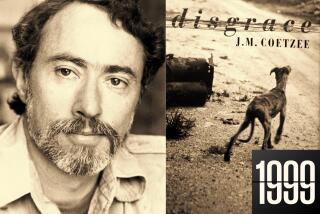A Country Where Only the Police Are Happy : WHITE BOY RUNNING <i> by Christopher Hope (Farrar, Straus & Giroux: $16.95; 272 pp.)</i>
- Share via
Christopher Hope writes about South Africa. He has approached the complexities of the place as a novelist, a poet and a short-story writer. Now, in a journalistic memoir called “White Boy Running,” Hope returns to a South Africa he left 13 years ago. It is the eve of the South African elections and these, Hope tells us, could well be the last white elections ever. It is an unexpectedly cheerful note in a book shorn of optimism.
The author returns to a town called Balfour--a halfway stop on the long journey from Johannesburg to the holiday beaches of Natal. It was here, at the beginning of the century, that Hope’s Irish-Catholic grandfather bought a hotel, at a time when the country seemed to be opening up after the ravages of the Boer War. It is good to be reminded that South Africa was not always the way it is now: a country where moving forward means marching backward as fast as possible and where only the police are happy.
It was also to Balfour that Hope came with his mother when his father died. Here, as a small boy, he enjoyed the warm company of the Afrikaner farmers, who shared his grandfather’s hatred of the British. Hope refers to himself as one of the children of apartheid; he was four in 1948 when the National Party came to power. This date rings like a dark bell throughout the book, which shifts back and forth in time, tracing the bloody history of the country from the days of the mighty Zulu wars, through the Boer War and on to South Africa today.
It is, of course, the history of people fighting for their freedom: the Zulus from the white invaders, the Boers from the British. As Hope points out, Afrikaner history is best understood by a trip to their shrines--the Voortrekker Monument, which commemorates the long trek into the interior by the founders of the Boer nation. And the lonely site of Blood River, where God miraculously intervened on behalf of the Boer to save him from the Zulu--a perpetual symbol, to the Afrikaner, that God had made his preference plain. From these beginnings, now steeped in myth and heroism, one can trace the heavy romanticism of Boer history, with its abomination of progress and its religious bigotry. These are now places where religious ceremonies pose as political rallies.
It is clear from this memoir that Hope felt himself an exile even before he left South Africa. He was a Catholic at school in the Protestant Afrikaner fortress of Pretoria; he saw the country as a place without reality and was unable to locate himself within it. He began to write because the quality of South African life had a fictional character. “It was as if the place was so absurd, so incredible, so terrifyingly funny that it was only by putting it into story form that you could believe in it.”
If this tells us why Hope began to write, it doesn’t tell us why he goes on writing about South Africa. Returning home, by his own definition, would seem to be going in search of something that doesn’t exist.
A clue to Hope’s obsession may be in his choice of metaphor: “The place is an infection, a lingering childhood disease I simply cannot get over.” This begs the question: Did he return to become reinfected, or to heal himself? Because in “White Boy Running”--in spite of the brilliance of its political commentary and the scathing irony that barely steers clear of despair--one sees another symptom of the South African disease: the inability to move on. Hope is telling ‘the old story’ again (a phrase he uses in “The Hottentot Room,” written in 1986), and it is a story that was probably told with the greatest power and effect in 1948, with Alan Paton’s “Cry the Beloved Country.”
So, has there really been no change at all? Well, it is permissible now to sleep with someone of another color in South Africa, but not to swim in the same part of the sea. The beaches are color-coded and any offspring from a mixed coupling will be treated likewise. It is certainly bizarre that, in a country so concerned with skin tone, it is also possible to change color. In 1986, 560 colored turned white and 666 were declared colored.
“White Boy Running” gets to the quick of many South African questions, and Hope reaches the very heart of apartheid when he calls it, “a family matter, a device for quarantining dubious relatives.” Nothing says more clearly how self-inflicted is the wound. Nothing is more disturbing than to visit the colored quarters of Cape Town and see in the slums there women with red hair, green eyes and the most Irish of complexions.
At the end of a book as eloquent and wise as this, all one can suggest is, perhaps the time has come for the white boy to stop running.
More to Read
Sign up for our Book Club newsletter
Get the latest news, events and more from the Los Angeles Times Book Club, and help us get L.A. reading and talking.
You may occasionally receive promotional content from the Los Angeles Times.







